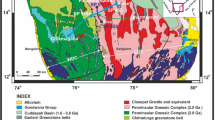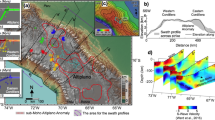Abstract
Continental plateaux, such as the Tibetan Plateau in Asia and the Altiplano–Puna Plateau in South America, are thought to form partly because upwelling, hot asthenospheric mantle replaces some of the denser, lower lithosphere1,2,3,4, making the region more buoyant. The spatial and temporal scales of this process are debated, with proposed mechanisms ranging from delamination of fragments to that of the entire lithosphere1,2,3,4. The Canadian Cordillera is an exhumed ancient plateau that abuts the North American Craton5. The region experienced rapid uplift during the mid-to-late Eocene, followed by voluminous magmatism6, a transition from a compressional to extensional tectonic regime7 and removal of mafic lower crust8. Here we use Rayleigh-wave tomographic and thermochronological data to show that these features can be explained by delamination of the entire lithosphere beneath the Canadian Cordillera. We show that the transition from the North American Craton to the plateau is marked by an abrupt reduction in lithospheric thickness by more than 150 km and that asthenosphere directly underlies the crust beneath the plateau region. We identify a 250-km-wide seismic anomaly about 150–250 km beneath the plateau that we interpret as a block of intact, delaminated lithosphere. We suggest that mantle material upwelling along the sharp craton edge9 triggered large-scale delamination of the lithosphere about 55 million years ago, and caused the plateau to uplift.
This is a preview of subscription content, access via your institution
Access options
Subscribe to this journal
Receive 12 print issues and online access
$259.00 per year
only $21.58 per issue
Buy this article
- Purchase on Springer Link
- Instant access to full article PDF
Prices may be subject to local taxes which are calculated during checkout



Similar content being viewed by others
References
Barnes, J. B. & Ehlers, T. A. End member models for Andean Plateau uplift. Earth-Sci. Rev. 97, 105–132 (2009).
Molnar, P., England, P. & Martinod, J. Mantle dynamics, uplift of the Tibetan Plateau, and the Indian monsoon. Rev. Geophys. 31, 357–396 (1993).
Garzione, C. N. et al. Rise of the Andes. Science 320, 1304–1307 (2008).
DeCelles, P. G., Ducea, M. N., Kapp, P. & Zandt, G. Cyclicity in Cordilleran orogenic systems. Nature Geosci. 2, 251–257 (2009).
Hyndman, R. D. & Currie, C. A. Why is the North America Cordillera high? Hot backarcs, thermal isostasy, and mountain belts. Geology 39, 783–786 (2011).
Dostal, J., Owen, J. V., Church, B. N. & Hamilton, T. S. Episodic volcanism in the Buck Creek complex (Central British Columbia, Canada): A history of magmatism and mantle evolution from the Jurassic to the early Tertiary. Int. Geol. Rev. 47, 551–572 (2005).
Armstrong, R. L. Mesozoic and early Cenozoic magmatic evolution of the Canadian Cordillera. Geol. Soc. Am. Spec. Pap. 218, 55–92 (1988).
Snyder, D. B., Pilkington, M., Clowes, R. M. & Cook, F. A. The underestimated Proterozoic component of the Canadian Cordillera accretionary margin. Geol. Soc. Lond. Spec. Publ. 318, 257–271 (2009).
Hardebol, N. J., Pysklywec, R. N. & Stephenson, R. Small-scale convection at a continental back-arc to craton transition: Application to the southern Canadian Cordillera. J. Geophys. Res. 117, B01408 (2012).
Iaffaldano, G., Bunge, H-P. & Dixon, T. H. Feedback between mountain belt growth and plate convergence. Geology 34, 893–896 (2006).
Mulch, A., Teyssier, C., Cosca, M. A. & Chamberlain, C. P. Stable isotope paleoaltimetry of Eocene core complexes in the North American Cordillera. Tectonics 26, TC4001 (2007).
Cook, F. A. et al. Lithoprobe crustal reflection cross section of the southern Canadian Cordillera, 1, Foreland thrust and fold belt to Fraser River fault. Tectonics 11, 12–35 (1992).
Hope, J. & Eaton, D. Crustal structure beneath the Western Canada Sedimentary Basin: Constraints from gravity and magnetic modelling. Can. J. Earth Sci. 39, 291–312 (2002).
Francis, D., Minarik, W., Proenza, Y. & Shi, L. An overview of the Canadian Cordilleran lithospheric mantle. Can. J. Earth Sci. 47, 353–368 (2010).
Eaton, D. W. et al. The elusive lithosphere–asthenosphere boundary (LAB) beneath cratons. Lithos 109, 1–22 (2009).
Simony, P. S. & Carr, S. D. Cretaceous to Eocene evolution of the southeastern Canadian Cordillera: Continuity of Rocky Mountain thrust systems with zones of “in-sequence” mid-crustal flow. J. Struct. Geol. 33, 1417–1434 (2011).
Cubley, J. F., Pattison, D. R. M., Archibald, D. A. & Jolivet, M. Thermochronological constraints on the Eocene exhumation of the Grand Forks complex, British Columbia, based on 40Ar/39Ar and apatite fission track geochronology. Can. J. Earth Sci. 50, 576–598 (2013).
Rippe, D., Unsworth, M. J. & Currie, C. A. Magnetotelluric constraints on the fluid content in the upper mantle beneath the southern Canadian Cordillera: Implications for rheology. J. Geophys. Res. 118, 5601–5624 (2013).
Yuan, H., Romanowicz, B., Fischer, K. M. & Abt, D. 3-D shear wave radially and azimuthally anisotropic velocity model of the North American upper mantle. Geophys. J. Int. 184, 1237–1260 (2011).
Miller, M. S. & Eaton, D. W. Formation of cratonic mantle keels by arc accretion: Evidence from S receiver functions. Geophys. Res. Lett. 37, L18305 (2010).
Currie, C. A., Huismans, R. S. & Beaumont, C. Thinning of continental backarc lithosphere by flow-induced gravitational instability. Earth Planet. Sci. Lett. 269, 436–447 (2008).
Levander, A. et al. Continuing Colorado plateau uplift by delamination-style convective lithospheric downwelling. Nature 472, 461–465 (2011).
Yang, Y. & Forsyth, D. W. Rayleigh wave phase velocities, small-scale convection, and azimuthal anisotropy beneath southern California. J. Geophys. Res. 111, B07306 (2006).
Mercier, J. P. et al. Body-wave tomography of western Canada. Tectonophysics 475, 480–492 (2009).
Lee, C. T. A. in Treatise on Geochemistry 2nd edn (eds Holland, H. D. & Turekian, K. K.) 423–456 (Elsevier, 2014).
Van Wijk, J. W. et al. Small-scale convection at the edge of the Colorado Plateau: Implications for topography, magmatism, and evolution of Proterozoic lithosphere. Geology 38, 611–614 (2010).
Eaton, D. W. & Claire Perry, H. K. Ephemeral isopycnicity of cratonic mantle keels. Nature Geosci. 6, 967–970 (2013).
Bao, X. et al. Lithospheric structure of the Ordos Block and its boundary areas inferred from Rayleigh wave dispersion. Tectonophysics 499, 132–141 (2011).
Bao, X. et al. Crust and upper mantle structure of the North China Craton and the NE Tibetan Plateau and its tectonic implications. Earth Planet. Sci. Lett. 369–370, 129–137 (2013).
Acknowledgements
Seismic data were downloaded from the Incorporated Research Institution for Seismology Data Management Center and Canadian National Data Center. This study was funded by the Natural Sciences and Engineering Research Council of Canada.
Author information
Authors and Affiliations
Contributions
X.B. performed Rayleigh-wave tomography. Thermal calculations and model conceptualization were provided by D.W.E. Thermochronologic data and concepts were provided by B.G. All authors contributed to discussion of the results and their implications, as well as preparation of the manuscript.
Corresponding author
Ethics declarations
Competing interests
The authors declare no competing financial interests.
Supplementary information
Supplementary Information
Supplementary Information (PDF 6691 kb)
Rights and permissions
About this article
Cite this article
Bao, X., Eaton, D. & Guest, B. Plateau uplift in western Canada caused by lithospheric delamination along a craton edge. Nature Geosci 7, 830–833 (2014). https://doi.org/10.1038/ngeo2270
Received:
Accepted:
Published:
Issue Date:
DOI: https://doi.org/10.1038/ngeo2270
This article is cited by
-
Seismically imaged lithospheric delamination and its controls on the Mesozoic Magmatic Province in South China
Nature Communications (2023)
-
Seismic evidence for a mantle suture and implications for the origin of the Canadian Cordillera
Nature Communications (2019)
-
Edge-driven convection and thinning of craton lithosphere: Two-dimensional thermal-mechanical modeling
Science China Earth Sciences (2019)
-
A Hybrid Multistage Model of Evolution of the Western Ghats at the Passive Western Continental Margin of India
Journal of the Geological Society of India (2018)
-
Late Triassic post-collisional slab break-off along the Ailaoshan suture: insights from OIB-like amphibolites and associated felsic rocks
International Journal of Earth Sciences (2017)



